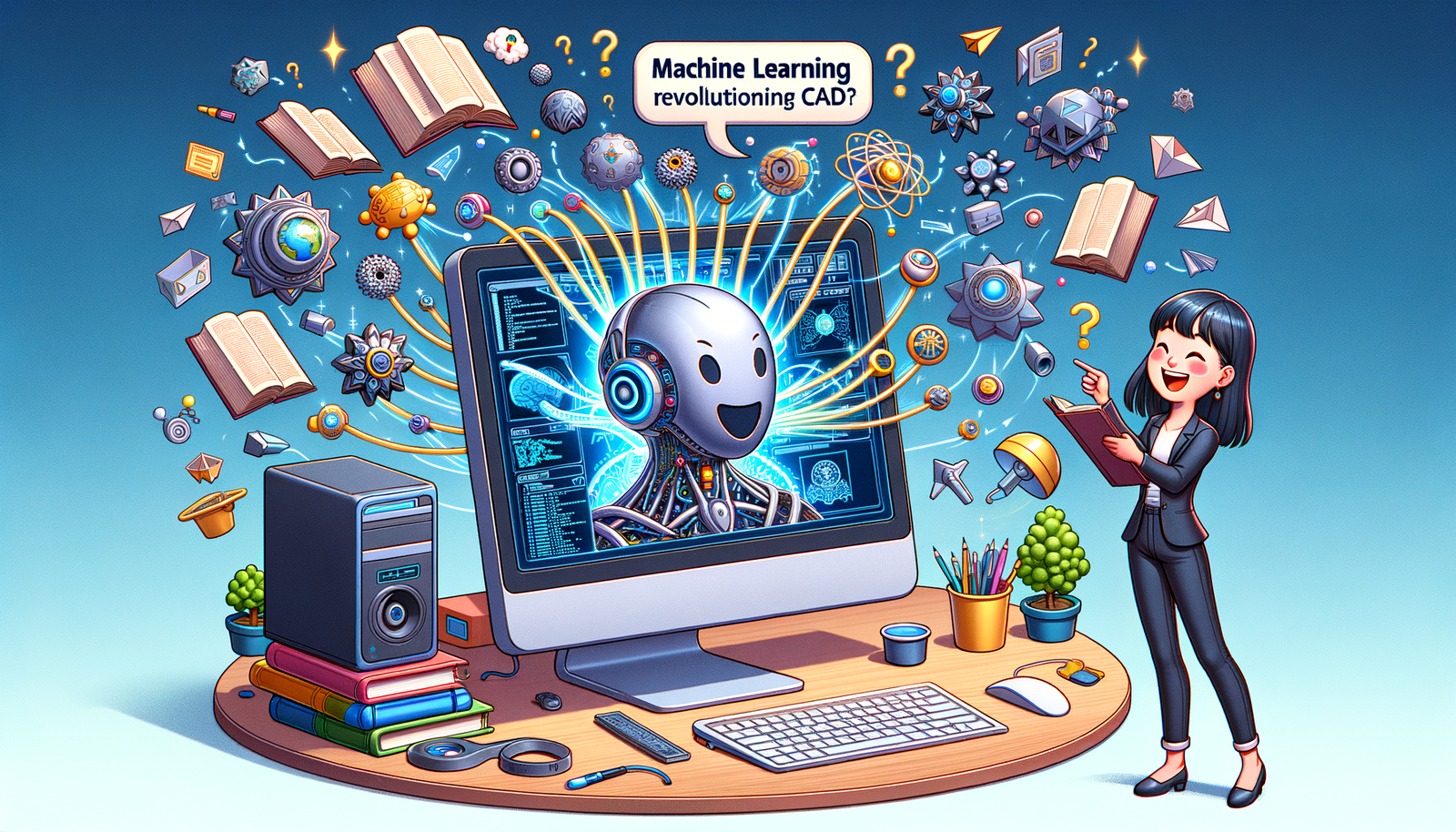Your Cart is Empty
Customer Testimonials
-
"Great customer service. The folks at Novedge were super helpful in navigating a somewhat complicated order including software upgrades and serial numbers in various stages of inactivity. They were friendly and helpful throughout the process.."
Ruben Ruckmark
"Quick & very helpful. We have been using Novedge for years and are very happy with their quick service when we need to make a purchase and excellent support resolving any issues."
Will Woodson
"Scott is the best. He reminds me about subscriptions dates, guides me in the correct direction for updates. He always responds promptly to me. He is literally the reason I continue to work with Novedge and will do so in the future."
Edward Mchugh
"Calvin Lok is “the man”. After my purchase of Sketchup 2021, he called me and provided step-by-step instructions to ease me through difficulties I was having with the setup of my new software."
Mike Borzage
Harnessing Machine Learning to Revolutionize CAD: Enhancing Efficiency, Accuracy, and Creativity in Design
September 29, 2024 7 min read


Introduction to Machine Learning and CAD
Computer-Aided Design (CAD) has been a cornerstone in the fields of engineering and design, revolutionizing the way professionals conceptualize, develop, and refine products and structures. CAD software enables designers to create precise drawings and models, facilitating complex calculations and simulations that were once time-consuming and prone to human error. As the demands of modern design and engineering grow, there's a pressing need to enhance these tools further. This is where Machine Learning (ML) comes into play. Machine Learning, a subset of artificial intelligence, involves training algorithms on data to enable them to make predictions or decisions without being explicitly programmed for specific tasks. Its transformative potential lies in its ability to learn from data patterns and improve over time, making processes more efficient and intelligent. By integrating ML into CAD systems, we can automate repetitive tasks, reduce errors, and open new horizons for innovation in design.
The Need for Efficiency in Design Processes
In the fast-paced world of design and engineering, efficiency is paramount. Designers often find themselves bogged down by repetitive tasks in CAD workflows that, while essential, consume valuable time that could be better spent on creative problem-solving and innovation. Tasks such as redrawing similar components, updating multiple instances of an object, or adjusting standard parameters across a project can be tedious and monotonous. Traditionally, these tasks have been managed manually or with rudimentary automation tools that lack adaptability. The inefficiencies of these traditional methods become apparent as project timelines shrink and the complexity of designs increases. There's a clear distinction between the need for precision and the desire for streamlined processes. Automation through Machine Learning offers a solution by intelligently handling repetitive tasks, learning from the designer's preferences, and adapting to the nuances of each project. This not only enhances productivity but also allows designers to focus on the strategic aspects of their work.
Overview of Machine Learning Techniques Applicable to CAD
Machine Learning encompasses a variety of techniques that can be tailored to specific applications within CAD. Among these, supervised learning involves training models on labeled datasets, allowing the algorithm to make predictions or classifications based on input data. This is particularly useful in CAD for tasks like feature recognition or predictive modeling, where past designs inform future suggestions. Unsupervised learning, on the other hand, deals with unlabeled data, enabling the discovery of patterns or groupings within the design data. This technique can assist in clustering similar design elements or identifying anomalies in structures. Reinforcement learning focuses on training algorithms through trial and error, where decisions are made to maximize a reward function. In CAD, this can facilitate optimization problems, such as finding the most efficient structural design under specific constraints. Algorithms like decision trees can help in making rule-based decisions for design modifications, while neural networks can model complex relationships in data, such as predicting stress points in a structure. The relevance of these algorithms to CAD lies in their ability to handle vast amounts of data and learn from it, leading to smarter and more adaptive design tools.
Integration of ML into Existing CAD Software Solutions
Leading CAD software vendors are increasingly recognizing the value of integrating Machine Learning into their platforms. This integration involves embedding ML algorithms into the software to enhance functionality and provide users with intelligent tools that augment their design capabilities. Vendors are incorporating features like predictive modeling, where the software suggests design elements based on the current project context, or automates the generation of complex geometries by learning from previous designs. For instance, some CAD platforms utilize ML to optimize component layouts, reduce material usage, or suggest alternative design approaches that meet the same requirements. The integration process requires careful consideration of the existing software architecture and user workflows to ensure that the ML features complement rather than complicate the user experience. By seamlessly embedding ML capabilities, CAD software becomes more responsive and adaptive, providing real-time assistance and reducing the cognitive load on designers.
Increased Productivity and Efficiency
The automation of repetitive tasks through Machine Learning significantly boosts productivity and efficiency in the design process. By delegating mundane tasks to intelligent algorithms, designers can save considerable time that would otherwise be spent on manual modifications and updates. For example, an ML-powered CAD system can automatically propagate changes across all instances of a component, ensuring consistency and reducing the likelihood of oversights. This not only accelerates the design cycle but also allows for quicker iterations, enabling teams to bring products to market faster. The time saved can be quantified through metrics that compare the duration of manual tasks versus automated processes. A few key areas where ML automation makes a substantial impact include:
- Automatic feature recognition: Identifying and categorizing design elements without manual input.
- Intelligent parameter adjustments: Adjusting design parameters globally based on learned relationships.
- Predictive maintenance suggestions: Anticipating design issues before they occur.
These efficiencies free up designers to engage more deeply with the creative aspects of their work, leading to more innovative and refined outcomes.
Improved Design Accuracy and Consistency
Machine Learning enhances design accuracy by minimizing human errors that often occur during repetitive tasks. When designers perform the same modifications repeatedly, fatigue and oversight can lead to inconsistencies that compromise the integrity of the design. ML algorithms, however, execute tasks with precision, adhering strictly to the defined parameters and learned patterns. This results in enhanced reliability in design outcomes, as the software can predict and correct potential errors before they propagate through the project. Moreover, ML models can learn from vast datasets, enabling them to recognize optimal design practices and apply them consistently. For instance, in structural design, an ML-enabled CAD system can predict stress concentrations based on previous models and suggest reinforcements accordingly. The reduction of errors not only improves the quality of the final product but also reduces the need for costly revisions and rework.
Enabling Designers to Focus on Creativity and Innovation
By offloading routine tasks to Machine Learning algorithms, designers are liberated to concentrate on the more creative and innovative aspects of their projects. This shift allows professionals to explore new ideas, experiment with unconventional solutions, and push the boundaries of their fields. Rather than spending time on repetitive modifications, designers can engage in strategic thinking, critical analysis, and conceptual development. ML automation thus transforms the role of the designer from an executor of tasks to a visionary and problem-solver. For example, with the assistance of ML, a designer can quickly generate multiple iterations of a design, each optimized for different criteria, and then focus on selecting or combining the best features from each. This accelerates the innovation process and leads to more advanced and sophisticated designs. By fostering an environment where creativity is prioritized, organizations can drive competitive advantage and achieve breakthroughs that were previously unattainable.
Potential Obstacles in Implementing Machine Learning in CAD
Despite the significant benefits, implementing Machine Learning in CAD comes with challenges that must be addressed. One of the primary obstacles is the issue of data quality and quantity. ML algorithms require large datasets to be effectively trained, and in the context of CAD, this means extensive libraries of design data that are accurately labeled and free of errors. Collecting and curating such datasets can be time-consuming and resource-intensive. Additionally, there may be concerns about data security and proprietary information, as sharing design data for ML purposes could pose risks. Another challenge is the resistance to change from traditional design practices. Many professionals may be hesitant to adopt new technologies that alter established workflows, especially if they perceive a steep learning curve or fear that automation could diminish their role. Overcoming this resistance requires demonstrating the tangible benefits of ML integration and providing adequate training and support. It's also essential to ensure that the ML tools are user-friendly and seamlessly integrate into existing systems.
Future Trends and Innovations
The future of Machine Learning in CAD is poised for exciting developments that will further transform the design landscape. Advancements in ML algorithms, such as deep learning and generative models, will enable even more sophisticated automation and predictive capabilities. These technologies can lead to tools that not only automate tasks but also generate design options from scratch based on specified criteria and constraints. The potential for increased personalization and customization in design tools is also significant. Designers will be able to tailor ML algorithms to their specific workflows and preferences, resulting in highly adaptive and responsive systems. Moreover, the integration of other emerging technologies, such as augmented reality and the Internet of Things (IoT), with ML-enhanced CAD systems will create immersive and interconnected design environments. This convergence will allow for real-time feedback from physical prototypes or operational data, informing the design process in unprecedented ways. As these trends unfold, the role of the designer will continue to evolve, with an emphasis on managing and guiding intelligent systems to achieve optimal outcomes.
Call to Action for CAD Professionals to Embrace ML
In light of the transformative potential of Machine Learning in CAD, it's imperative for design professionals to embrace these technologies to remain competitive in the field. Adopting ML-enhanced CAD tools offers a pathway to greater efficiency, accuracy, and innovation. Professionals should actively seek out opportunities to learn about ML, whether through formal training, workshops, or collaborative projects. Experimentation with ML features within CAD software can help designers become familiar with the capabilities and limitations of these tools, allowing them to integrate them effectively into their workflows. Organizations should support this transition by investing in updated software, providing educational resources, and fostering a culture that values technological advancement. By taking proactive steps to incorporate Machine Learning into their practice, CAD professionals can position themselves at the forefront of the industry, driving progress and setting new standards for excellence in design and engineering.
Also in Design News

Rhino 3D Tip: Enhance Rhino 3D Workflow with Custom Scripting for Automation and Efficiency
November 25, 2024 2 min read
Read More
Integrating Ethical AI in Design Software: Ensuring Transparency, Fairness, and User Privacy
November 25, 2024 5 min read
Read More
Design Software History: CATIA's Evolution: Transforming Aerospace and Automotive Design Software
November 25, 2024 5 min read
Read MoreSubscribe
Sign up to get the latest on sales, new releases and more …


